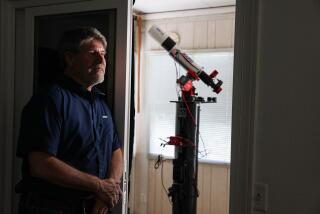Volunteer gamers trump computers, and science is the winner
- Share via
Supercomputers may routinely defeat human chess champions these days, but sometimes regular folks still beat out fancy technology. An example published in the journal Nature this week: Lay people were better than a computer program dreamed up by scientists at figuring out how a complicated protein takes its shape.
In a broad array of disciplines — molecular biology, astronomy, archaeology and more — researchers are outsourcing their time-consuming dirty work to volunteer gamers and everyday people with some extra hours on their hands, with promising results.
Foldit, the game featured in the Nature article, lets people tackle a problem that stumps computers — how proteins fold up into complicated three-dimensional structures. Players don’t need to know any science; they just need to use their spatial reasoning abilities.
In a head-to-head competition, Foldit players performed better than the computer program in five of the 10 puzzles they faced, reported University of Washington biochemist David Baker, who developed the game and the computer program. The computer only beat the gamers by a significant margin in two of the 10 puzzles.
It’s similar to a three-dimensional Tetris game. Proteins, the molecular machines that do myriad jobs inside cells, can very rapidly fold up into a compact, functional structure. Each protein has a particular shape, but scientists don’t understand how the molecule “knows” what that shape is supposed to be, and the computer programs designed so far can only figure out the answer for the very simplest ones.
Furthermore, if the computer program makes a mistake early on, say, by leaving a hole where none should be, it has a hard time fixing it because it generally doesn’t undo its work. People, on the other hand, can easily see the hole, determine that large-scale changes are needed, and go backward to fix it.
There are still some points where the computer excels — gamers have a hard time starting from scratch and doing the final fine-tuning — but Baker said he was impressed and inspired by the players’ creativity.
“The sophistication and cleverness and insight in the strategies that people developed was really amazing,” he said. “They came up with ideas that I really never had thought of.”
For those who are a little less intellectually inclined — and blessed with lots of patience — there’s also plenty of citizen-scientist work of the needle-in-a-haystack variety.
More than 29,000 people are registered with Stardust@home, sorting through about a million grainy images taken of a capsule of a spacecraft that returned to Earth in 2006 looking for evidence of tiny bits of interstellar dust.
“We think that the solar system formed from a cloud of exactly this stuff,” said UC Berkeley astronomer Andrew Westphal, who directs the volunteer-led effort. “We’re trying to understand the earliest history of the solar system.”
Originally, he planned to use a computer program to identify the distinctive particles, but then “realized we had no idea how to write an algorithm that could do it,” he said.
Casual observers visiting his lab, on the other hand, had no problem finding the dust. Inspired, and “desperate,” he said, he launched Stardust@home in 2006.
Since then, “dusters” have combed through the images, racking up a total of 75 million searches. Finally, in March of this year, the first two stardust candidates were identified by Bruce Olson of Ontario, Canada, who had been a carpenter and groundskeeper before a stroke left him unable to work.
“He’d rather do this than watch soap operas,” Westphal said.
Two more discoveries followed, announced last week at the Meteoritical Society meeting in New York City. Naomi Wordsworth, a London woman who works in electronics, found one; there is some uncertainty about which duster first found the other piece, but the researchers are close to announcing a winner, who will be given the opportunity to name the precious speck.
Despite these human triumphs over computers, the machines are still better for some tasks. In these cases, would-be scientists who aren’t willing to donate their brainpower can offer their home computer’s number-crunching abilities instead. Climateprediction.net, run by a team at Oxford University, uses personal computers to run state-of-the-art climate simulations.
And SETI@home, run by UC Berkeley computer scientist David Anderson, uses volunteer computers to sort through radio signals in search of extraterrestrials — but they haven’t found any yet.
Other opportunities for citizen scientists include Galaxy Zoo, run by a self-described “motley collection of astronomers and developers” hailing from various institutions, mostly in the U.S. and Britain, which is asking volunteers to determine whether galaxies are spiral or elliptical. Another is Hominids@home, a yet-to-be-launched project by UC Berkeley archaeologist Tim White that will enlist viewers to find fossils without ever getting dirty.
rachel.bernstein@latimes.com






